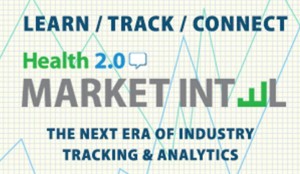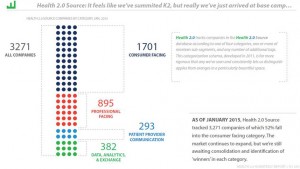 They’re the team that built a brand with the phrase “Health 2.0” before the world barely recognized v 1.0 in healthcare. This week, those folks that brought you the Health 2.0 Conference unveiled the Market Intel database of over 3,000 companies, trying to make sense out of a very blurry and fast-morphing market landscape. I spoke with Matthew Holt and Kim Krueger of Health 2.0 earlier this week to discuss just what’s in this mine of information, and what they intend to do with it.
They’re the team that built a brand with the phrase “Health 2.0” before the world barely recognized v 1.0 in healthcare. This week, those folks that brought you the Health 2.0 Conference unveiled the Market Intel database of over 3,000 companies, trying to make sense out of a very blurry and fast-morphing market landscape. I spoke with Matthew Holt and Kim Krueger of Health 2.0 earlier this week to discuss just what’s in this mine of information, and what they intend to do with it.
In full disclosure, I have been a colleague and friend of Matthew Holt since his first job out of Stanford University health policy school, when we collaborated at Institute for the Future on health policy and technology forecasts, like this one for the Robert Wood Johnson Foundation published in 2003. [For a laugh, here’s a link to one of our reports on the prescription drug IT ecosystem, written in 2006, on behalf of the California HealthCare Foundation. Yes, Matthew and I go way back]. I have also attended every annual northern California-based Health 2.0 Conference since launching in 2007, and often participate in the agenda.
 The organization has been collecting data about so-called Health 2.0 companies from the beginning, when PatientsLikeMe and Allscripts were much younger organizations in the first-gen of H2.0. Now, the database has grown into what Matthew described as, “a living, breathing, ongoing repository.” That repository is organized across four categories: consumer-facing (currently representing over one-half of the companies inventoried), professional-facing (just under one-fourth of the companies), data/analytics/exchange (382 companies in 1Q15), and patient-provider communications (293 companies).
The organization has been collecting data about so-called Health 2.0 companies from the beginning, when PatientsLikeMe and Allscripts were much younger organizations in the first-gen of H2.0. Now, the database has grown into what Matthew described as, “a living, breathing, ongoing repository.” That repository is organized across four categories: consumer-facing (currently representing over one-half of the companies inventoried), professional-facing (just under one-fourth of the companies), data/analytics/exchange (382 companies in 1Q15), and patient-provider communications (293 companies).
Underneath these for macro categories are “segments” — some 19 of them — covering applications. These include, for consumers, self-management tools and trackers (by far the largest segment across all of 19), content, communities and coaching; B2B administrative and workflow tools for clinicians; and decision support analytics dominating the data/analytics/exchange category. The patient-provider communications category isn’t broken out into any segments underneath that umbrella.
Below the segments, then, are tags — allowing users to dive into specific areas like nutrition tracking, gaming, revenue cycle management, or Internet of Things, for example.
This database will enable Health 2.0 to provide a portfolio of offerings to prospective users, from a bundle of business intelligence products and custom content creation, to specific research reports that cover a niche on-demand.
Here’s the press release on the program.
Health Populi’s Hot Points: So what the heck is Health 2.0 anyway? Is it “digital health,” “mobile health,” “telehealth?” It’s all of that, and more.
In an article called Definition of Health 2.0 and Medicine 2.0 – a systematic review, published in the Journal of Internet Medical Research in 2010, researchers from Radboud University found, “there is still no general consensus regarding the definition of Health 2.0/Medicine 2.0” after conducting an extensive study of the literature. They concluded: “Health 2.0/Medicine 2.0 is still a developing concept. Our study identified 46 unique definitions of Health 2.0 and Medicine 2.0 with seven recurrent topics: Web 2.0/technology, patients, professionals, social networking, health information/content, collaboration, and change of health care.”
Let me call out those “seven recurrent topics,” which are the underlying core of Health 2.0 – Web 2.0; patients and professionals; social networking; health content; collaboration; and change of health care.
Regardless of which of 46 (and growing) definitions one might (conceptually) buy, these are indeed the shared traits of Health 2.0 technologies. These are the tools that will indeed change health care, if anything can, for the better, in our journey toward The Triple Aim. This new database, which will be ever-green (according to Matthew’s quote, above) can help those seeking to assess, invest in, buy, or compete with new-new tools for health care. I myself am looking forward to mining the data on a micro level where I can dive deep based on tags that will be useful in my own forecasting and advisory work.
Thanks for doing such heavy-lifting, team Health 2.0. I’m going to hold you to that promise of continuing to build out this strategically important resource.




 I am so grateful to Tom Lawry for asking me to pen the foreword for his book, Health Care Nation,
I am so grateful to Tom Lawry for asking me to pen the foreword for his book, Health Care Nation,  I love sharing perspectives on what's shaping the future of health care, and appreciate the opportunity to be collaborating once again with Duke Corporate Education and a global client on 6th May. We'll be addressing some key pillars to consider in scenario planning such as growing consumerism in health care, technology (from AI to telehealth), climate change, and trust -- the key enabler for health engagement or dis-engagement and mis-information. I'm grateful to be affiliated with the corporate education provider
I love sharing perspectives on what's shaping the future of health care, and appreciate the opportunity to be collaborating once again with Duke Corporate Education and a global client on 6th May. We'll be addressing some key pillars to consider in scenario planning such as growing consumerism in health care, technology (from AI to telehealth), climate change, and trust -- the key enabler for health engagement or dis-engagement and mis-information. I'm grateful to be affiliated with the corporate education provider  Thank you FeedSpot for
Thank you FeedSpot for